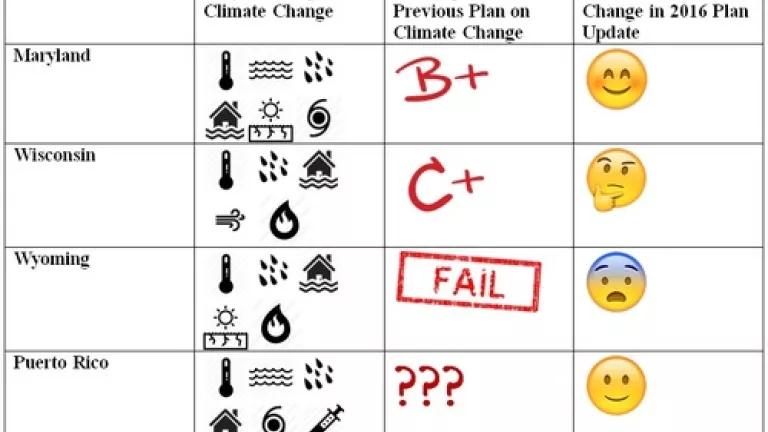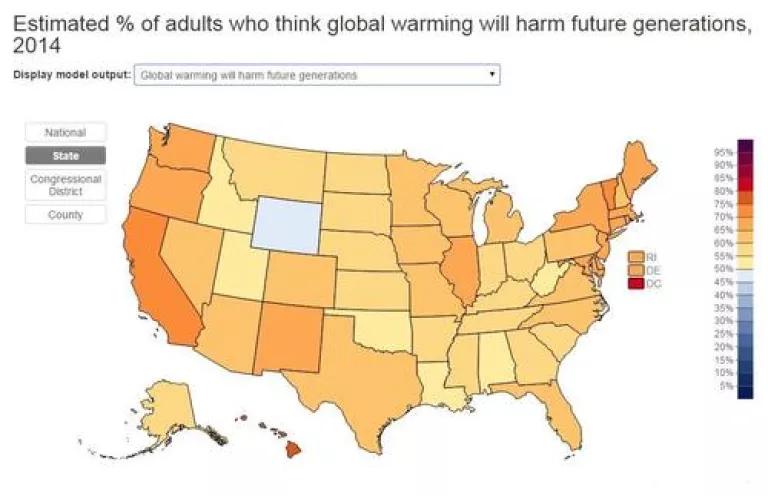Wyoming's 2016 Disaster Plan Update: Ignoring Climate Change Could Put the Cowboy State at Risk (Part 4 of 5)

As I previewed on Monday, this week we're taking an in-depth look at the four U.S. jurisdictions who are required to update their State Hazard Mitigation Plans in 2016 to account for the projected effects of climate change. On Monday we looked at Maryland, which we expect to develop one of the year's strongest plans. Yesterday we checked out Wisconsin, where politics could interfere with state agency staff's intentions to strengthen their plan. Today we're turning our attention to Wyoming, where climate change has rarely been acknowledged, much less integrated into state plans.
Deadline for Wyoming's plan update: June 2016
Projected climate change impacts:
- According to the National Climate Assessment, projections suggest more frequent and more intense droughts, heavy downpours, and heat waves.
- Right now, for an average of seven days per year, maximum temperatures reach more than 95°F in the Northern Plains (including Wyoming). These high temperatures are projected to occur much more frequently, even under a scenario of substantial reductions in heat-trapping gas emissions, with days over 100°F projected to double in number in the north by mid-century.
- Future climate change projections include more precipitation in the Northern Great Plains as well. Extreme precipitation has been increasing strongly in the Great Plains, Midwest, and Northeast, where river flooding increases have been observed. The number of days with heavy precipitation is expected to increase by mid-century, especially in the north, leading to increased flooding.
- At the same time, projections suggest more frequent and more intense droughts.
- Climate change is projected to continue contributing to increased wildfires across the American west.
Does the state's previous hazard mitigation plan take climate change into account?
In 2014, FEMA changed its policy on hazard mitigation plan updates, requiring updates every five years instead of the former interval of every three years. Under the three-year policy, Wyoming's deadline was 2014, but because of the two-year extension, it's now 2016 (as with the other jurisdictions discussed in this post). However, Wyoming had already completed its plan update in accordance with the 2014 deadline. It is unclear whether the state will update it further before re-submitting it to FEMA in 2016.
HEAD IN THE SAND: The 2014 version of Wyoming's plan does not mention climate change at all or consider the possibility of changing future conditions. The probability of hazard occurrence is calculated exclusively using historical data ("by dividing the number of recorded occurrences by the number of recorded years.") For example, the 2014 plan estimates the probability of drought through the following formula: 50 Drought Years Reported ÷ 117 years = 43% annual probability of drought.
GRADE: F. As we know, because of climate change, our previous risk of natural disasters is not necessarily the same as our future risk. The approach taken in Wyoming's 2014 hazard mitigation plan turns a blind eye to the effects of climate change and thereby fails to fully consider the risk of flooding, drought, extreme weather, and other future hazards.

According to a Yale University study, Wyoming is the only state in the nation where less than half of the population believes climate change will harm future generations. Image credit: Yale Project on Climate Change Communication.
How much money is at stake?
Wyoming hasn't received as much money through FEMA's hazard mitigation grant programs as some other states - only about $7.5 million to date. However, those funds (which are contingent upon the state having an approved hazard mitigation plan) have been used for important projects like making homes and schools more resistant to earthquakes, protecting roads from flooding, and installing siren alert systems.
What can we expect from Wyoming in the 2016 plan?
As discussed above, it is unclear whether Wyoming will make further changes to the 2014 plan before submitting it to FEMA again next year. Unlike state agency staff in Maryland and Wisconsin, Wyoming's Office of Homeland Security has not been forthcoming about the state's plans or hazard mitigation process in general. In a news story about the new FEMA policy earlier this year, a state representative declined to answer questions about whether Wyoming would include climate change in future plans.
Reading the tea leaves, we're not overly optimistic about Wyoming's 2016 plan including climate change. Wyoming has not developed any sort of comprehensive climate adaptation plan. The state's governor, Matt Mead, is a long-time climate skeptic. However, this year he began to express willingness to take steps to tackle the problem, while maintaining his doubt about the science. While that's a positive step, we haven't seen any actions from his administration to reduce or prepare for the impacts of climate change in any way.
We urge Wyoming to take this opportunity to incorporate climate change projections into the state's plan. The science is clear that the probability of future hazards is not the same as past hazards, but the current plan includes no analysis of how climate change might make natural disasters more frequent or severe. Wyoming must do better in order to protect people, property, and the environment into the future.
NEXT UP: Check back tomorrow for a look at the final jurisdiction with a 2016 plan update - Puerto Rico.

